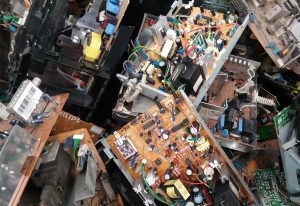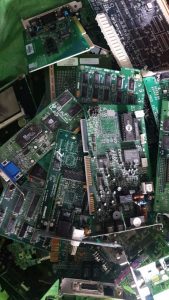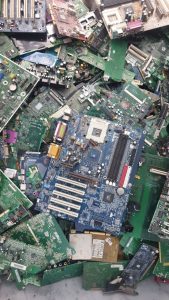Electronic waste management
 Electronic waste (electronic waste) is one of the fastest growing areas of the international waste stream. According to European Union research, they are growing by around 3-5%. per year or about three times faster than other individual waste streams.
Electronic waste (electronic waste) is one of the fastest growing areas of the international waste stream. According to European Union research, they are growing by around 3-5%. per year or about three times faster than other individual waste streams.
Some authors argue that the fast-growing electronics industry, driven by the growing demand for information and communication technologies around the world, coupled with rapid product aging and a lack of inadequate end-of-life management capabilities, has led to unsustainable waste stream management. To deal with the flow of e-waste, various countries are practicing many measures: environmental friendliness, cleaner production, greater producer responsibility, standards and labeling, product maintenance, recycling, and so on. Manufacturers are expected to be responsible for electronic products throughout their life cycle. During production, they must take into account the problem of electronic waste at the stage (ecology, cleaner production) and participate in e. in a waste management system that complies with the requirements of EU directives and national laws.
 Electronic waste management systems have been installed in all European and some Asian and American countries. The systems have some differences, but they all work on the same principle: they help to collect and manage electronic waste.
Electronic waste management systems have been installed in all European and some Asian and American countries. The systems have some differences, but they all work on the same principle: they help to collect and manage electronic waste.
As we can see, producers, recyclers and government organizations are very much involved in the problem of e-waste. However, the generation of electronic waste and its efficient treatment are closely linked to consumers of electronic products.
Electronic waste is a problem that affects consumers in two ways: when an obsolete product needs to be replaced and when old equipment is discarded. In addition to lost storage space, recycling and disposal fees, and potential environmental pollution from recycling and disposal processes, the accrued costs to consumers from replacing this equipment can be significant. Regarding the e-waste problem, consumers can be divided into two groups: the consumer as an EE customer (consumer) and the consumer as an e-waste holder (disposer). Both roles express the middle stage of the product life cycle, namely the use stage, and the middle stage between other stakeholders, namely the producer and the processor. Both roles are crucial in tackling e-waste. Consumption is also an important issue as the increasing consumption of EE provides a huge amount of obsolete electronics.
Regarding the e-waste problem, consumers can be divided into two groups: the consumer as an EE customer (consumer) and the consumer as an e-waste holder (disposer). Both roles express the middle stage of the product life cycle, namely the use stage, and the middle stage between other stakeholders, namely the producer and the processor. Both roles are crucial in tackling e-waste. Consumption is also an important issue as the increasing consumption of EE provides a huge amount of obsolete electronics.


